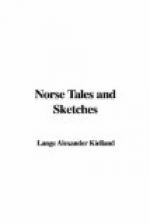And thus most of us go through life, and down into a hole in the ground like moles, without having taken any notice of the bird that flew or the bill that sang. We believe that the small birds are sparrows, the larger probably crows; barndoor fowls are the only ones we know definitely.
I met a lady the other day who was extremely indignant about this. She had asked the man at whose house she was staying—a very intelligent peasant—what kind of bird it was that she had seen in the fields. It was evident that it was a thrush—merely a common thrush—and she described the bird to him: it was about half as large as a pigeon, gray and speckled with yellow; it hopped in the fields, and so on.
‘Would it be the bird they call a swallow?’ suggested the man.
‘Not at all,’ replied the lady angrily. ’I rather think it was a kind of thrush.’
‘Oh! then you had better ask my wife.’
‘So she understands birds, does she?’ exclaimed the lady, much mollified.
’Yes, she is mad with them, they do so much mischief among the cherries.’
With this my lady had to go. But the story is not yet finished; the worst is to come.
For when, indignant at the countryman’s ignorance of the bird-world, she told all this in town, there was one very solemn gentleman who said:
‘Are you sure that it was not a gull?’
This went beyond all bounds, thought my lady, and she came and complained bitterly to me.
When wild-geese fly in good order, as they do when in the air for days and nights together, the lines generally form the well-known plough, with one bird at the point, and the two next ones on either side of him a little way behind.
Hitherto I have always been content with the explanation that we received and gave one another as boys, viz., that the birds chose this formation in order to cleave the air, like a snow-plough clearing a way.
But it suddenly occurred to me the other day that this was pure nonsense—an association of ideas called forth by the resemblance to a plough, which moves in earth or snow, but which has no meaning up in the air.
What is cloven air? And who gets any benefit by it?
Yes, if the geese flew as they walk—one directly behind the other—there might perhaps, in a contrary wind, be some little shelter and relief for the very last ones. But they fly nearly side by side in such a manner that each one, from first to last, receives completely ‘uncloven’ air right in the breast; there can be no suggestion that it is easier for the last than for the first bird to cut a way.
The peculiar order of flight has quite another meaning, viz., to keep the flock together on the long and fatiguing journey; and if we start from this basis, the reasoning thought becomes also evident in the arrangement itself.
Out here by the broad Aarre Water there pass great flights of wild-geese; and in bad weather it may happen that they sit in thousands on the water, resting and waiting.




